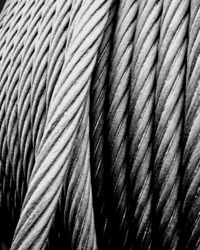
Photo from wikipedia
To ensure the safety of cable-stayed bridges, a long-term condition evaluation method has been proposed based on dead load–induced cable forces. To extract dead load–induced cable forces under random vehicle… Click to show full abstract
To ensure the safety of cable-stayed bridges, a long-term condition evaluation method has been proposed based on dead load–induced cable forces. To extract dead load–induced cable forces under random vehicle loadings, a novel approach is first developed by integrating influence lines with monitoring data. Then, based on the extracted dead load–induced cable forces, the evaluation algorithm for stay cable systems is presented. In the assessment algorithm, uniform and non-uniform characteristics are taken into account. Finally, the Third Nanjing Yangtze River Bridge, a typical large span cable-stayed bridge, is used to illustrate the effectiveness of the proposed methodology. As a result, the maximum relative error in extraction of dead load–induced cable forces accounts for 4.78% within the studied five stay cables. The precision of the extraction method is acceptable for practical applications since the relative error is less than 5%. Moreover, the bridge is continuously assessed using the dead load–induced cable forces for 5 years. Eliminating the influence of vehicle loadings, the condition of the bridge gradually degrades with time but still remains in good condition. The study not only provides a long-term condition evaluation method for stay cable systems but a dead load–induced extraction approach under random vehicle loadings, which will help bridge owners know well the condition of bridges to make appropriate maintenance decisions.
Journal Title: Advances in Structural Engineering
Year Published: 2019
Link to full text (if available)
Share on Social Media: Sign Up to like & get
recommendations!